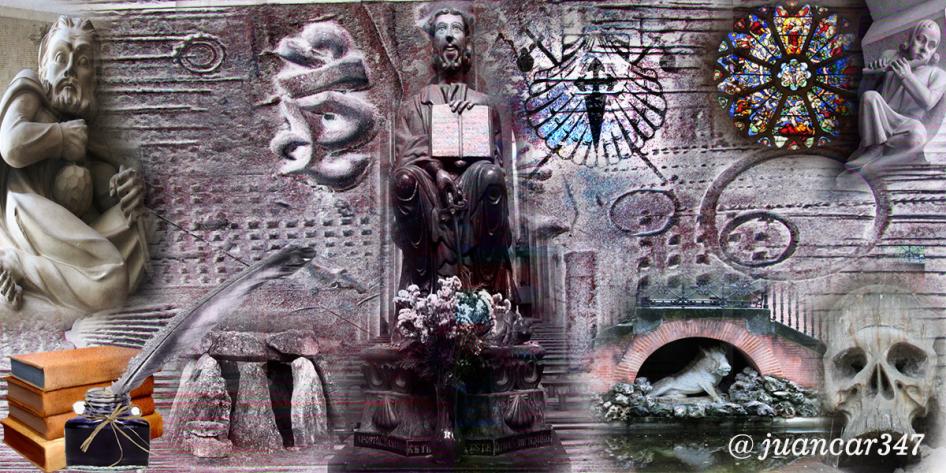The enigmatic Atlantean of San Pantaleón de Losa
Comment C.G. Jung, in that small but at the same time great biography that is his book 'Memories, dreams, thoughts' (1), that being very young, 'could deepen in the world of the enigmatic'. And he did, of course, in a way that recalls, by its similarity, that great medieval spirit, which was Bernardo de Clairvaux or Clairvaux-San Bernardo-since like this one, he recognized that this world of the enigmatic belonged ' the trees, the river, the swamp, the stones, the animals, and even - enviable detail - 'the library of his father'.

That 'enigmatic world', sensed, then, by San Bernardo in the 12th century and by Gustav Jung at the end of the 19th century and the beginning of the 20th century, is no other, in the end, than the one that the pilgrim finds himself on that screen mythological, that after all and symbolically speaking, does not stop being the Way of the Stars or the Strange Way of Santiago.

A Way - and I do well to grant it the blessing of a capital - in which the natural and the artificial merge, until forming a monumental scenario in which the pilgrim-a Janus, who even without knowing it, carries with him the spirits of the Major Arcana of the Tarot, corresponding to the Madman and the Magician - wanders through a monumental panel, in which he is reaping triumphs and disappointments; joys and sorrows and in which, through his ability and self-control, he observes how his ego is tempered, at a slow, but sure fire, of a strange knowledge, conformed by archetypes that attract or repel him, with an unusual force.

Basically, this is what you experience when you get to a place as charismatic and yet so strange, as is the church of San Pantaleón, located in the Burgos neighborhood of Losa, anchored its foundations almost on the edge of an antediluvian promontory, which by its shape, it resembles the keel of a ship sinking into an abysmal sea, which in this case would be no other, than a land that has known parideras of a thousand and one races, civilizations and condition.

Indeed, before Celts, Romans, Visigoths, Muslims, Jews and Christians left that metaphorical graffiti of the 'I was here', which are the remnants of his presence, now covered by silence and oblivion, although overlapping one another as the layers of an onion overlap, unknown palaeolithic guturalities looked with fearful eyes towards this place, whose top, beaten by the wind in its four sides, received obituaries of servitude and forgiveness, in honor of unknowable gods, who like Jonah, finished in the insatiable stomach of new whales, called Religion.

It is not strange, therefore, that these puddles come from those puddles -as my invaluable friend and Master, Mr. Rafael Alarcón Herrera would say- and among the motley sculpture of the church, dedicated to the hermetic figure, galena and of questionable origin, as is San Pantaleón, strange elements are found, whose vision, as well as surprising, cause a shudder of uncontrollable magnitude. Such would be the case, of the enigmatic Atlantean, located on the left side of the main portico of access to the church, attracts much more attention than that basin or cauldron, from which arise several small heads, which pretending to emulate the inventions of the supposed miracles of the 'doctor-martyr-saint' Pantaleon or of the 'popular-equal-and-so-so' Nicholas, does not remember, but the magical cauldron of the Celtic deity Dagda - at the deepest level, the bowl, basin or cauldron, would be nothing more than a metaphor of the unconscious - capable of resurrecting the dead, a subject that, believe it or not, was later picked up by the scriptwriters of the film and the Stargate series, albeit transformed into 'the horse of San Miguel', a term with which , in certain medieval areas, they referred to the coffin.

Perhaps, that ancient sculpture represented a Roman patrician, with part of his toga reclined on his shoulder, although perhaps the little dexterity of the stonemason who executed it, gave it the shape of a sack. Detail, by which is popularly known as 'the man of the bag', sinister character, invented by popular wisdom to keep at bay the restless children, facing the threat that he could come and take them forever.

Anyway, although inside the church the stone coffin is kept, where the mortal remains of the saint supposedly rested, San Pantaleón is no longer what it was, having lost the element 'miraculous', 'magical' or 'goetic' ', which attracted the pilgrims who arrived at the Cantabrian ports -Santoña, Laredo, San Vicente de la Barquera, Llanes- and entered the Plateau, reaching the Merindades through the dangerous port of the Escudo: the blister with the blood in dust of the saint, which miraculously liquefies every year in July, coinciding with his name day and the years he has not done so, great catastrophes happened, including, it is said, the fateful Second World War.

Currently, the ampoule is in Madrid, in the Royal Monastery of the Incarnation, where it was donated, in the seventeenth century, by the Count of Miranda - at that time, Viceroy of Naples - on the occasion of the entry into the convent of his daughter Aldonza.

Related movie:

designed by: @txatxy
Congratulations, Your Post Has Been Added To The Steemit Worldmap!
Author link: http://steemitworldmap.com?author=juancar347
Post link: http://steemitworldmap.com?post=the-enigmatic-atlantean-of-san-pantaleon-de-losa
Want to have your post on the map too?
Thanks